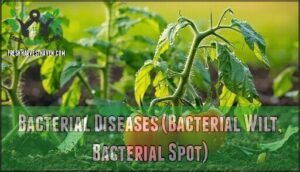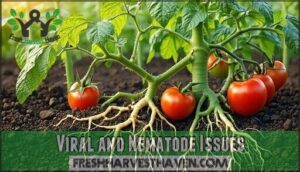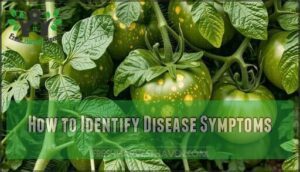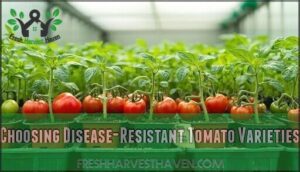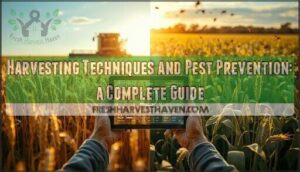This site is supported by our readers. We may earn a commission, at no cost to you, if you purchase through links.
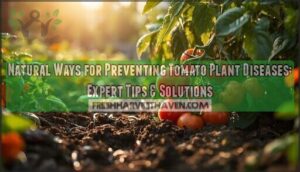 Your tomato plants looked perfect last week. Now brown spots creep across the leaves, stems wilt despite regular watering, and white powder dusts the foliage like someone shook flour over your garden.
Your tomato plants looked perfect last week. Now brown spots creep across the leaves, stems wilt despite regular watering, and white powder dusts the foliage like someone shook flour over your garden.
Most gardeners reach for synthetic fungicides at the first sign of trouble, but diseases that took decades to develop resistance to chemicals often surrender to nature’s own defenses.
The secret isn’t fighting harder—it’s working with your soil’s biology, choosing varieties that shrug off infections, and timing your interventions before problems take hold. Prevention beats cure every time, and your garden already contains most of the tools you need.
Table Of Contents
- Key Takeaways
- Common Tomato Diseases and Their Signs
- Choosing Disease-Resistant Tomato Varieties
- Creating Healthy Soil for Tomatoes
- Watering and Mulching for Disease Prevention
- Natural and Organic Disease Control Methods
- Cultural Practices for Healthier Tomato Plants
- Advanced Strategies for Long-Term Disease Prevention
- Frequently Asked Questions (FAQs)
- What is the best natural fungicide for tomato plants?
- Why should you sprinkle baking soda around your tomato plants?
- Can companion plants help prevent tomato diseases?
- How does pruning timing affect disease prevention?
- Do homemade fertilizers influence plant disease resistance?
- What environmental factors worsen existing tomato diseases?
- How do seasonal weather patterns impact prevention?
- How often should tomato plants be fertilized naturally?
- What companion plants repel aphids from tomato gardens?
- Can compost tea prevent fungal infections in tomatoes?
- Conclusion
Key Takeaways
- Prevention through proper plant selection, soil health, and cultural practices proves far more effective than treating established infections, with disease-resistant varieties and beneficial soil microbes like Bacillus subtilis reducing disease incidence by over 80%.
- Smart watering and mulching techniques—particularly drip irrigation combined with organic mulch barriers—prevent the moisture-related conditions and soil splash that trigger most fungal and bacterial tomato diseases.
- Crop rotation every three years disrupts disease cycles embedded in soil, delivering up to 46% yield increases while drastically reducing soilborne pathogens and nematode populations that plague consecutive plantings.
- Natural interventions like neem oil, companion planting with basil and marigolds, and weekly applications of diluted organic sprays (chamomile, baking soda, or milk) provide 70-80% disease control without synthetic chemicals when applied preventively.
Common Tomato Diseases and Their Signs
Tomato plants face all kinds of threats, and some are easier to spot than others. Knowing how to catch trouble early makes all the difference in keeping your harvest healthy.
As you look over your tomato plants, keep an eye out for these signs.
Fungal Diseases (Early Blight, Late Blight, Powdery Mildew)
Even the best tomato patch can fall prey to fungal diseases like early blight, late blight, and powdery mildew. These troubles thrive where humidity lingers, spore dispersal goes unchecked, and air flow stalls.
Disease prevention hinges on resistant rootstocks, Blight forecasting, organic disease control methods, and consistent mildew treatments—think humidity control, mulching, and vigilant pruning to hold losses at bay.
To manage this, consider using a disease forecasting model to time fungicide applications.
Bacterial Diseases (Bacterial Wilt, Bacterial Spot)
Once you’ve dealt with fungal invaders, bacterial threats—like wilt and bacterial spot—may still hide out in soggy soil or among last season’s debris.
Catching these bacteria early can make all the difference, since skipping crop rotation or proper sanitation lets disease severity spiral quickly.
Bring in Organic Solutions such as Bacillus subtilis, rely on Soil Solarization, and keep up Disease prevention to outwit Pathogen Persistence. One major concern is Ralstonia solanacearum presence, a bacterium that causes southern bacterial wilt.
Viral and Nematode Issues
While you’re tackling bacterial threats, it’s important not to overlook how quickly viral diseases and nematode damage can strike.
Insects or seeds often spread viruses, causing rapid trouble above ground, while nematodes quietly wreak havoc on roots below.
- Disease-resistant varieties
- Crop rotation
- Resistant rootstock
- Biocontrol efficacy (e.g., Bacillus subtilis)
- Prioritizing soil health and organic matter
How to Identify Disease Symptoms
Spotting the early warning signs on your tomato plants is a bit like catching those first clues of a cold—you save yourself a lot of trouble by recognizing them right away. Blackening leaves, unusual viral distortions, or leaf spot ID issues all deserve a second look.
Keep an eye out for spore identification, and check trusted online resources if you’re unsure.
Choosing Disease-Resistant Tomato Varieties
Picking the right tomato variety makes a big difference in how your plants resist disease. There are a few key things you’ll want to look for before you buy seeds or seedlings.
Take a look at these tips as you weigh your choices.
Understanding Disease Resistance Labels
Ever wondered what those cryptic little letters on tomato seed packets actually mean for your garden’s health? Decoding label codes opens the door to smarter choices in DiseaseResistant Varieties. Here’s what you’ll find:
- "VFN" means resistance to Verticillium, Fusarium, and Nematodes.
- New resistance genes broaden your tomato cultivar disease resistance.
- Seed company variations exist.
- Local adaptation matters most.
Top Resistant Tomato Cultivars
A wise choice of tomato cultivars can save you countless headaches down the line. Disease-resistant varieties like ‘Iron Lady Hybrid’ and ‘Mountain Magic’ wield proven disease resistance genes and hybrid vigor.
Regional performance matters too—select cultivars bred for local challenges.
Breeding innovations now bring considerable disease resistance in tomato varieties, without sacrificing heirloom flavor.
Role of Certified Seeds
When you start with certified seeds, you’re giving your tomato crop a running start toward healthy, problem-free growth.
Seed certification benefits you by ensuring genetic purity assurance, variety authenticity, and a disease-free guarantee. These tomato seeds meet strict legal seed standards, helping prevent seedborne diseases and boosting disease resistance in tomato varieties—essential for dependable tomato disease prevention, season after season.
Creating Healthy Soil for Tomatoes
Healthy soil is your tomato plants’ first line of defense against disease. Getting the basics right now makes a big difference later.
Before you dig in, here are a few essentials to keep in mind.
Importance of Organic Matter
Think of organic matter as the engine behind healthy tomato plants—boosting soil microbial diversity, jump-starting natural disease suppression, and helping roots thrive.
With organic fertilizer, you gain richer soil structure and stronger plants, see real yield increase benefits, and minimize soilborne diseases.
It’s your first line of organic disease control, laying the foundation for reliable tomato disease prevention and plant health.
Proper Soil Preparation Techniques
Getting your soil in shape for tomatoes is a bit like prepping your kitchen before cooking—everything turns out better when you start clean, organized, and ready. Begin with a soil test to check Soil pH and Nutrient Balance.
Add Organic Amendments, like compost, for Drainage Improvement and to reduce Soilborne diseases. Always loosen soil well—proper Soil preparation for tomatoes keeps pathogens at bay.
Sterilizing Tomato Seeds
Ever wondered if something as simple as cleaning your tomato seeds could be the secret weapon against next season’s stubborn plant diseases?
Sterilizing tomato seeds—using Seed Sterilization Methods like a hot water treatment or a short bleach solution soak—can break disease cycles.
Just make sure to follow each step, including seed drying, to prevent recontamination and boost your garden’s odds.
Crop Rotation Benefits
Rotating your crops acts like hitting the reset button for your soil, helping refresh its health and fend off common diseases along the way.
Crop rotation does more than boost yield improvement—it stops soilborne diseases in their tracks, improves nutrient cycling, aids organic disease control, and makes proactive measures against pest reduction and disease suppression part of your gardening routine.
Watering and Mulching for Disease Prevention
Getting your watering and mulching routine right can make all the difference for healthy tomato plants. A few simple changes in how you water and protect the soil go a long way in keeping diseases at bay.
As you plan for a healthier, more productive crop, keep these tips in mind.
Effective Watering Techniques (Drip Irrigation, Avoiding Overhead)
By shifting your watering to drip irrigation, you prevent foliar disease and limit soil splash, two key triggers for tomato diseases. Overhead irrigation—especially late in the day—keeps leaves wet, opening the door to fungal infections.
Smart irrigation timing and sticking to drip methods provide excellent water efficiency, healthier plants, and less disease worry in your tomato patch.
Benefits of Mulching for Disease Control
Drip irrigation helps keep plant leaves dry, but adding mulch gives you an extra layer of defense against soil-borne diseases.
Mulching acts as a moisture barrier, blocking fungal spore splash and shielding plants from soil-borne pathogens. Whether you use straw, compost, or another mulch type, you’ll notice reduced infection rates—a major advantage for organic disease control.
Preventing Soil Splash and Moisture Issues
When you keep mulch in place, you’re not just locking in moisture—you’re also stopping rain from splattering bits of soil up onto your tomatoes, where trouble often starts.
Mulch types like straw or compost form soil barriers that keep soilborne pathogens at bay. Pair this with drip irrigation, smart pruning strategies, and airflow optimization to outsmart most soilborne diseases.
Natural and Organic Disease Control Methods
Keeping your tomato plants healthy doesn’t mean you have to rely on harsh chemicals. There are plenty of simple, natural remedies that work with nature instead of against it.
Here are a few reliable organic solutions you can try right in your own backyard.
Neem Oil and Horticultural Spray Oils
Think neem oil is just old folklore? Modern trials prove its value—Neem oil efficacy rates soar as high as 73% disease reduction and 82% yield improvement under pressure.
Applying horticultural oil at safe rates boosts organic disease control, limits fungal threats, and furthers resistance management strategies—all while offering real economic impact and peace of mind in your tomato patch.
Organic Chamomile and Baking Soda Sprays
If you’re looking to outsmart fungal diseases with simple pantry solutions, chamomile tea and baking soda sprays quietly pack a punch against problems before they take hold.
- Chamomile spray benefits: natural antifungal shield.
- Baking soda ratios: 1 teaspoon per quart, always dilute.
- Spray application timing: dawn or dusk prevents leaf burn.
- Fungal disease control: repeat weekly after rain.
- Homemade spray safety: test on one leaf first.
Milk and Garlic Oil Sprays
From the kitchen to the garden, a splash of milk or a whiff of garlic oil can make a surprising difference in keeping tomato diseases at bay.
Milk spray benefits include boosting plant health and acting as a gentle organic fungicide, especially when applied weekly.
Garlic oil recipes safely deter fungal spores; combining sprays strengthens disease prevention. Consistent application boosts organic disease control.
Proper Use of Unsulfured Blackstrap Molasses
You mightn’t expect a sticky, dark sweetener to play a role in your tomato patch, but unsulfured blackstrap molasses feeds beneficial soil microbes that help your plants resist disease naturally. This molasses nutrient boost works as a soil amendment and microbial food, strengthening plant health through organic disease control.
Application methods for fungal control:
- Dilute properly: Mix 1–2 tablespoons per gallon of water for foliar sprays or soil drenches.
- Apply consistently: Use biweekly during the growing season to maintain microbial populations.
- Combine strategically: Pair with compost tea to boost organic fungicides and disease prevention efforts.
Cultural Practices for Healthier Tomato Plants
Beyond choosing the right varieties and amending your soil, how you manage your tomato plants day-to-day makes all the difference in keeping diseases at bay. Simple cultural practices—the hands-on routines you follow in the garden—create an environment where tomatoes thrive and pathogens struggle.
Here are some practical ways you can keep your tomatoes in top shape throughout the entire growing season.
Proper Spacing and Air Circulation
Crowded tomato plants are like a packed subway car during flu season—disease spreads fast when there’s no room to breathe. Give each plant at least 2 feet of space to boost air flow and reduce fungal infections.
Adequate plant spacing combined with strategic airflow pruning creates circulation methods that keep foliage dry. Clear weeds regularly—they block circulation and harbor pathogens. Install support structures early to keep plants upright and improve tomato plant air circulation for effective disease prevention.
| Spacing Benefits | Why It Matters |
|---|---|
| 2-3 feet between plants | Prevents humidity buildup, reducing fungal spread |
| Vertical support structures | Lifts foliage off ground, improving airflow |
| Regular weed control | Eliminates airflow barriers and disease hosts |
Pruning and Removing Infected Material
Snipping off diseased leaves isn’t just tidying up—it’s stopping an infection before it turns your entire plant into a pathogen buffet. Use clean pruning techniques and practice tool sterilization between cuts—wipe shears with rubbing alcohol to avoid spreading foliage diseases.
Early detection matters, so inspect plants weekly. Trim bottom leaves touching soil first, then bag infected material for proper waste disposal. These sanitation procedures are essential tomato plant care that protects your garden maintenance efforts.
Weeding and Sanitation Strategies
Weeds aren’t just stealing water and nutrients—they’re also choking out airflow and creating damp hideouts where pathogens thrive. Weed control starts with proper weed identification, then hand-pulling or shallow cultivation that won’t disturb roots.
Garden hygiene means debris removal too—gather fallen leaves and spent plants daily. Compost healthy waste separately from diseased material.
These sanitation procedures and garden maintenance habits are your frontline defense for preventing tomato plant diseases.
Supporting Plants to Prevent Disease Spread
Staking or caging your tomato plants does more than keep them organized—it lifts foliage and fruit off the ground where moisture and soil-borne pathogens lurk. Choose sturdy caging methods or staking tomatoes early, then tie stems gently as they grow.
Combine this with pruning techniques—removing lower leaves improves airflow optimization and prevents splash-back during watering. These proactive measures strengthen your sanitation procedures and keep air flow moving freely.
Advanced Strategies for Long-Term Disease Prevention
Once you’ve mastered the basics of tomato care, it’s time to think bigger and longer-term. The strategies below build a foundation that protects your plants year after year, breaking disease cycles before they start.
These approaches work together to create a resilient garden that stays healthier with each growing season.
Crop Rotation and Disease Cycle Disruption
When you plant tomatoes in the same spot year after year, you’re basically rolling out the welcome mat for disease-causing pathogens that thrive in the soil and debris left behind. Crop rotation disrupts this cycle by rotating plant families every three years.
These proactive measures for disease management boost yield increase impact by up to 46% while raising soluble protein levels in your tomatoes. Additionally, they help control soilborne diseases, reduce nematode population issues, and cut soil nitrate reduction by 23%.
Companion Planting and Pest Control
Planting tomatoes alongside the right companions naturally helps keep pests in check, sparing you from having to use chemicals.
Companion plants like basil and marigolds serve as natural repellents through allelopathic effects, while trap cropping with nasturtiums diverts aphids away from your tomatoes.
These organic pest control methods attract beneficial insects that disrupt pest lifecycles, reducing damage before it starts.
Utilizing Beneficial Microbes (e.g., Bacillus Subtilis)
Inoculating your soil with beneficial microbes like Bacillus subtilis delivers powerful disease suppression and growth enhancement without synthetic chemicals. These naturally occurring bacteria colonize tomato roots, producing antimicrobial compounds that inhibit pathogens like bacterial wilt and Fusarium while triggering the plant’s own disease resistance mechanisms.
Field trials show microbe application can reduce disease incidence by over 80% while boosting yields, making it an essential proactive measure for soil health and organic control.
Selecting and Applying Resistant Varieties and Advanced Mulches
Pairing genetically resistant cultivars with organic or plastic mulch creates a dual-shield defense that blocks disease before it takes hold.
Start with disease-free seedlings carrying genetic resistance markers proven against threats like ToBRFV and early blight. Apply mulch at planting time to immediately prevent soil splash, the main pathway for fungal spores to reach leaves.
This combination of cultivar resistance and improved mulch types delivers proactive measures that stop infections before symptoms appear.
Frequently Asked Questions (FAQs)
What is the best natural fungicide for tomato plants?
Organic fungicides like Bacillus subtilis top the list for natural pest control and disease management.
Copper alternatives, including homemade solutions with essential oils or plant extracts, effectively combat fungal diseases without harsh chemicals.
Why should you sprinkle baking soda around your tomato plants?
Talk about a "base" instinct—baking soda benefits tomato plants through pH alteration and fungal inhibition. Sprinkling it around your plants creates an alkaline barrier that disrupts fungal growth, supporting disease prevention.
Application methods include light dusting or diluted sprays for effective disease management against common fungal diseases.
Can companion plants help prevent tomato diseases?
Yes, companion plants can help reduce tomato diseases. They attract beneficial insects that prey on pests, deter harmful insects through allelopathic effects, and act as trap crops, increasing biodiversity and improving overall pest management organically.
How does pruning timing affect disease prevention?
Timing separates success from struggle—prune during dry mornings in the Best Pruning Season to minimize Pruning Wound Susceptibility.
Low Humidity After Pruning and improved Air flow prevent Fungal diseases from entering fresh cuts, protecting Tomato plant health through smart Post-Pruning Care and Disease prevention.
Do homemade fertilizers influence plant disease resistance?
Homemade fertilizers can strengthen disease resistance when the fertilizer nutrient balance promotes immunity. Compost tea effects include microbial fertilizer interactions that boost plant defenses.
However, homemade fertilizer risks arise from contamination or imbalance, potentially compromising tomato plant health despite proactive measures.
What environmental factors worsen existing tomato diseases?
A local grower once lost half her greenhouse crop when a humid week turned mild leaf spots into full-blown blight. Excessive humidity and poor ventilation create the perfect storm—when air flow stagnates around damp foliage, soilborne pathogens thrive.
Temperature swings stress plants, making them vulnerable, while inconsistent watering saturates soil and keeps humidity high. Limited sunlight exposure weakens defenses further, turning manageable infections into devastating losses under compromised growing conditions.
How do seasonal weather patterns impact prevention?
Seasonal humidity and rainfall impact create prime growing conditions for fungal spores, while temperature effects determine pathogen activity.
Wind patterns spread disease between plants, and limited sunlight exposure weakens natural defenses, making prevention timing critical throughout the season.
How often should tomato plants be fertilized naturally?
You’ll want to feed your tomatoes every two to three weeks once they start flowering, using compost tea or well-aged manure.
Soil testing helps identify nutrient deficiency signs before they appear, preventing issues that could weaken plants and invite fungal problems.
What companion plants repel aphids from tomato gardens?
Like your grandmother’s victory garden relied on marigolds, you can use aphid-repelling herbs like basil, chives, and cilantro alongside flower companions such as nasturtiums for trap cropping.
These companion planting strategies attract predators and beneficial insects, naturally controlling insect pests through organic pest control methods.
Can compost tea prevent fungal infections in tomatoes?
Compost tea benefits include introducing beneficial microbes that may suppress fungal diseases in tomatoes. However, tea effectiveness varies based on brewing compost tea methods and application frequency.
While organic fungicides show promise for disease management, research on specific fungi control remains limited.
Conclusion
An ounce of prevention beats a pound of cure, especially when preventing tomato plant diseases naturally. These strategies—disease-resistant varieties, healthy soil biology, smart watering, companion planting, and timely organic interventions—work together like layers in a defense system.
Your garden doesn’t need synthetic chemicals when you’ve built resilience from the ground up. Start with one or two practices this season, observe what your plants tell you, and adjust.
Healthy tomatoes aren’t about ideal results; they’re about creating conditions where disease struggles to gain a foothold.
- https://www.almanac.com/10-secrets-growing-tomatoes
- https://hgic.clemson.edu/factsheet/tomato-diseases-disorders/
- https://extension.missouri.edu/publications/mg13
- https://www.thespruce.com/identify-treat-prevent-tomato-diseases-7153094
- https://www.researchgate.net/publication/357519537_PREVENTION_AND_CONTROL_OF_TOMATO_DISEASES_AND_PESTS


